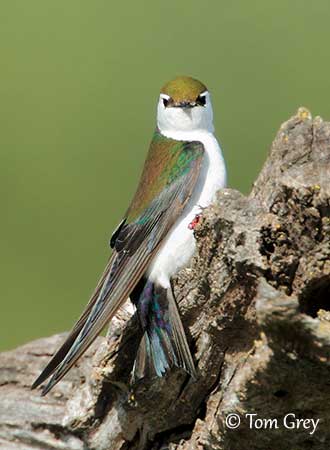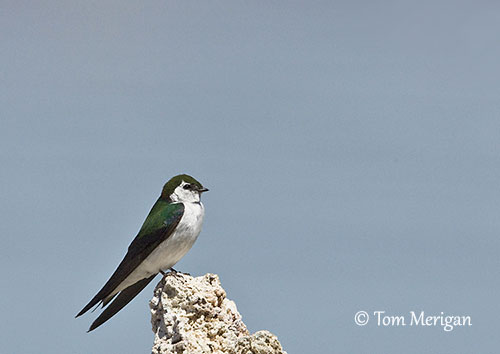
Fr: Hirondelle à face blanche
Ang: Violet-green Swallow
All: Veilchenschwalbe
Esp: Golondrina Verdemar
Ita: Rondine verdeviola
Nd: Groene Zwaluw
Sd: violettgrön svala
Photographers:
Tom Grey
Tom Grey's Bird Pictures & Tom Grey's Bird Pictures 2
Tom Merigan
Tom Merigan’s Photo Galleries
Simon Tan
PBase Bird galleries
Text by Nicole Bouglouan
Sources:
HANDBOOK OF THE BIRDS OF THE WORLD Vol 9 - by Josep del Hoyo - Andrew Elliot - David Christie - Lynx Edicions - ISBN: 8487334695
All About Birds (Cornell Lab of Ornithology)
What Bird-The ultimate Bird Guide (Mitchell Waite)
Wikipedia, the free encyclopaedia
Bird Web (Seattle Audubon Society)
National Park Service – Brice Canyon
Violet-green Swallow
Tachycineta thalassina
Passeriformes Order – Hirundinidae Family
INTRODUCTION:
The Violet-green Swallow is found in the West of North America, from Alaska to central Mexico where it frequents open woodlands, mountains and suburbs.
It nests in natural cavities such as holes in trees or rock crevices, but it also uses artificial nest-boxes. It feeds mainly on various insects caught in flight or low over water surface in bad weather.
The Violet-green Swallow is usually fairly common throughout the range, but the species is affected by the loss of natural nest-sites through deforestation, but also by competition for nesting cavities with introduced bird species.
But currently, it is not globally threatened.

DESCRIPTION OF THE BIRD:
Biometrics:
Length: 12-13 cm
Weight: 14-16 g
The Violet-green Swallow adult male has green mantle, scapulars and back, whereas the uppertail-coverts are violet-blue. There is an extensive white patch on each side of the rump, making the bird almost white-rumped in flight. The long, pointed wings are black. The black tail shows a shallow fork.
The underparts are white, except for the pale grey underwing-coverts.
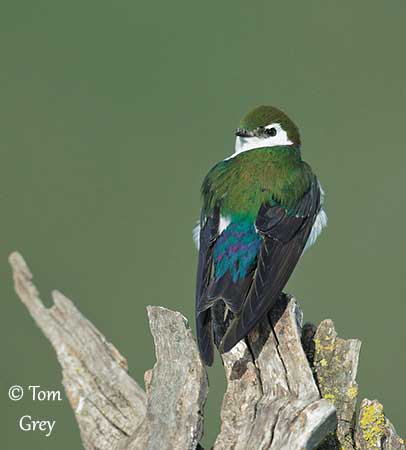
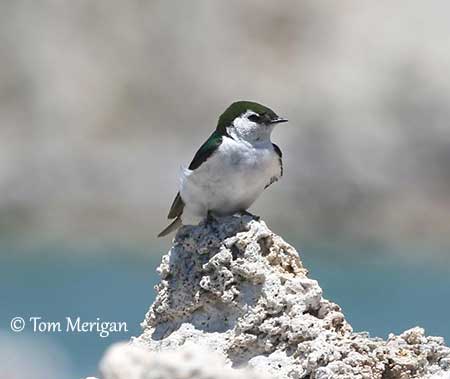
On the head, forehead, crown and nape are green, with violet wash on the nape. Head sides are white, including the eye’s area.
The small, pointed bill is black. The eyes are dark brown. Legs and feet are punkish to blackish.
The female is duller, with browner to bronze head.
The juvenile is browner, mostly greyish-brown above and white below with pink legs and feet.
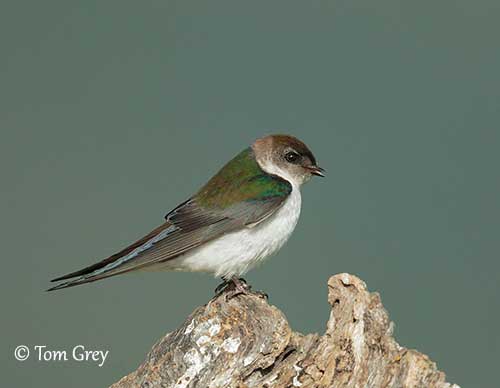
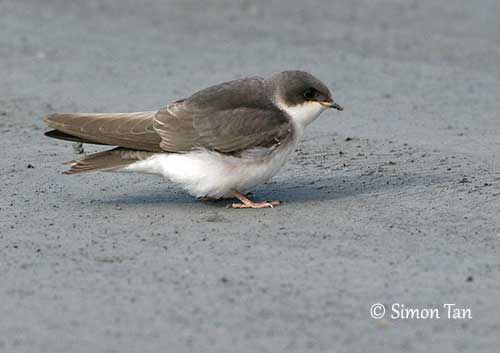
SUBSPECIES AND RANGE:
The Violet-green Swallow has two subspecies.
T.t. thalassina (described above) is found in C Alaska and W Canada, S in W USA to S Arizona and S New Mexico.
It winters in Baja California S to N Nicaragua.
T.t. brachyptera is found in NW Mexico, C and S Baja California, S Sonora.
This race is smaller than nominate, and the violet gloss on scapulars and back is less conspicuous.
HABITAT:
The Violet-green Swallow breeds in open forests, mountains and suburban areas. The nesting habitat may include pine forests, aspen groves, canyon walls in mountains and open prairies with suitable nest-sites. This species nests between 1,500 and 3,000 metres of elevation, sometimes up to 4,000 metres. In Mexico, it is known for its nesting habits with the nest placed in hole in giant cactus in desert.
During winter, it is mostly found at low elevations in valleys, coastal plains and intertidal flats, but it also occurs over plains and forests up to 3,000/3,700 metres of elevation.
During migration, it is often seen near water, along rivers, lakes and coastlines.
CALLS AND SONGS: SOUNDS BY XENO-CANTO
The Violet-green Swallow gives a high “dee-chip” in flight. We can also hear a series of varying tweet notes used in courtship and territorial behaviours. The contact call between the members of a group is “chee-chee”.
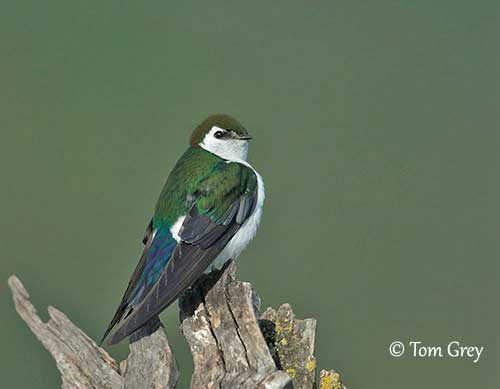
BEHAVIOUR IN THE WILD:
The Violet-green Swallow feeds on insects caught in flight. Insect diet includes ants, beetles, flies, moths, mayflies and some wasps and bees.
It forages in flight and usually flies higher than other swallow species. In bad weather, it may fly low over ponds to catch prey.
It often hunts in flocks or small groups, sometimes with other swallows and swifts. It may occasionally feed on the ground, but rarely.
The Violet-green Swallow nests in isolated pairs or in small colonies of up to 25-50 pairs. They arrive on their breeding grounds some weeks before to start the breeding season.
While the female builds the nest, the male guards her, including during the egg-laying period, in order to defend its paternity.
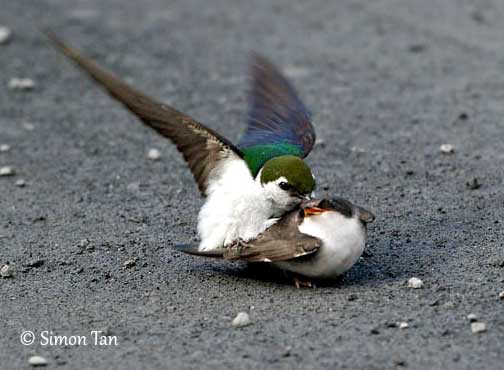
Competition for nesting cavities and nest boxes often occurs, especially with the Common Starling and the House Sparrow, both introduced species.
The male arrives first and starts to display to claim the territory and a nest-site. It flies and circles over the site, and then dives back down to the nest and sings at the entrance. These displays may vary according to the species. Later during the season, the nest is strongly defended by both adults.
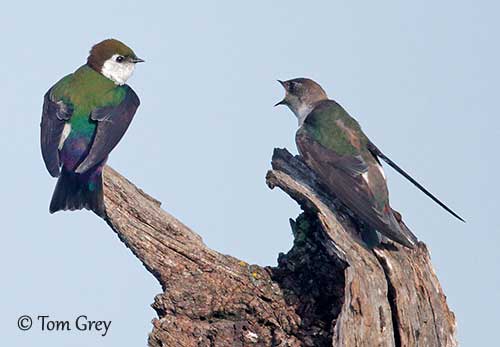
The Violet-green Swallow of nominate race is a long-distance migrant. It returns to the breeding sites mid-March to early May, and often returns to the same site. They migrate during the day.
The race “brachyptera” performs altitudinal movements and moves from mountains to lower elevations in Mexico.
This swallow is vagrant to Aleutian Islands, and also to Manitoba, Ontario, Ohio, New Jersey, C Texas, Yucatán, and in South America to N Colombia.
It has fast and graceful flight, very agile when hunting on the wing.
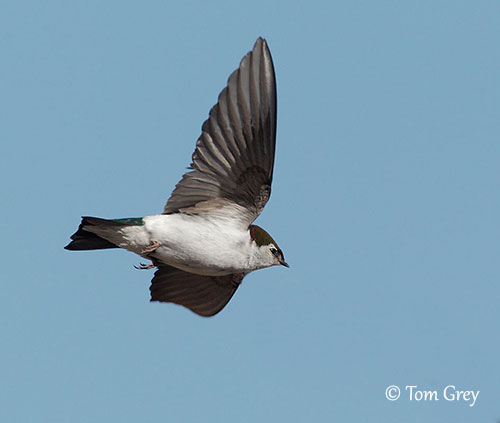
REPRODUCTION OF THIS SPECIES:
The breeding season takes place between May and August, but from February in Mexico.
The Violet-green Swallow breeds solitary or in loose colonies of 25-50 pairs. It is a cavity nester and uses a variety of natural cavities such as old woodpecker holes, tree holes, rock crevices but also artificial bird houses. In Mexico, it often nests in holes in giant cactus.
The nest is built by both adults but mainly by the female. The cup-shaped structure is made with grass, twigs and rootlets, and the cup is lined with feathers.
The female lays 4-6 white eggs and incubates alone during 13-18 days. Both parents feed the chicks but the female more than the male. The young fledge 23-24 days after hatching, and they are still fed by the adults for some time.
This species produces a single brood per season, rarely two.
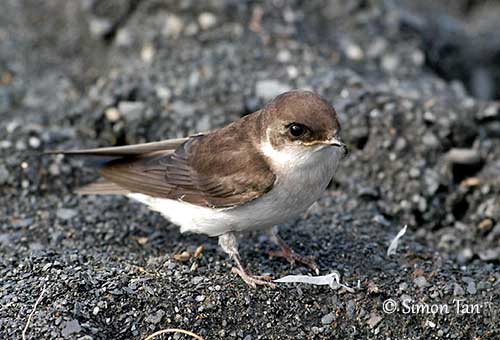
PROTECTION / THREATS / STATUS:
The Violet-green Swallow has benefited from artificial nest boxes in some areas, but it may suffer from competition for nest-sites with introduced species such as the Common Starling and the House Sparrow. Deforestation also involves loss of natural sites.
The population is estimated to number 11,000,000 individuals, and is locally increasing.
The species is usually fairly common and not globally threatened.
The Violet-green Swallow is currently evaluated as Least Concern.
